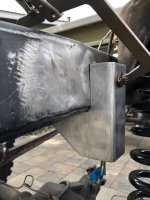Ok what would be the cause of death wobble and what would be the cause of bumps steer?
Bumpster is caused by a couple of things. Maybe more.
One is a misalignment of the linkage as was described.
Another is too acute of an angle on the linkage. Such as after a suspension lift, but not compensating for the changed angle with things like Pitman arms and brackets to correct for the steeper angle.
The steeper angle, the more shift occurs during suspension cycling.
There may be specific definitions for Bumpster that don’t include some of the things mentioned, but the end result is the same. A vehicle that moves side to side on the road without input from the driver and is less than perfectly stable while driving.
Death Wobble is caused by tires.… There are things that can allow it to happen when it wouldn’t otherwise be occurring, but it always starts at the tires.
There are lots of discussions about it, and lots of arguments about what the actual causes are. But I’m firmly encamped in the “Always starts with a tire” camp.
So if its main thing is going to be on street driving and little off roading . Would the TRO and riser be over kill?
Generally, yes.
If I had a smaller lift like a 2.5 would it not affect the pinion angle as much or is it always necessary to cut and turn the axle with a lift?
It does not affect it as much. But it might still be necessary.
As we say around here, every Bronco is different…
But because of production tolerances, and old school thinking, your bronco might not have had enough caster right from the factory.
That’s why we usually recommend having it checked before starting work on suspension and steering. In fact, now is the time to suggest it.
If you’re Bronco is still together and driving, go get the alignment checked and get an actual real world caster number to work with.
Back when Broncos were strictly manual steering and had bias ply tires, the front axle caster numbers were set up much less than was called for on paper.
This made it easier to steer, and didn’t cause too many problems for old-school truck savvy, Bronco owners back in the day.
Now that we have radial tires, cushier suspensions, better shocks, and are much more used to good handling vehicles, it’s a big annoyance to not have proper caster.
Also what are the positive and negative of drop radius arm vs long arm?
Positives as they are cheaper and easy to gain caster reasonably while keeping the spring cups aligned.
Negatives are, there are ugly, they hang down too low for offloading, they impart more leverage into the frame, and still don’t correct the real correct way.
Which is to cut and turn…
But here again, getting the caster checked ahead of time wiill let you know what you have to work with. And what you have to compensate for.
Since it’s not going off road, and likely won’t ever see four-wheel-drive high on the street, you may never experience a drive line vibration from a bad pinion angle.
Most of us have not done a cut and turn, so you may not have to either.
























